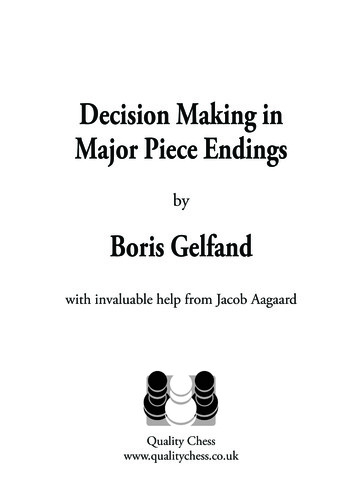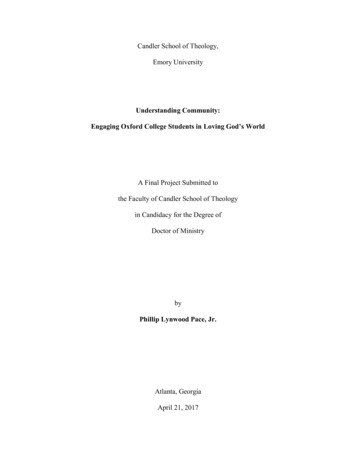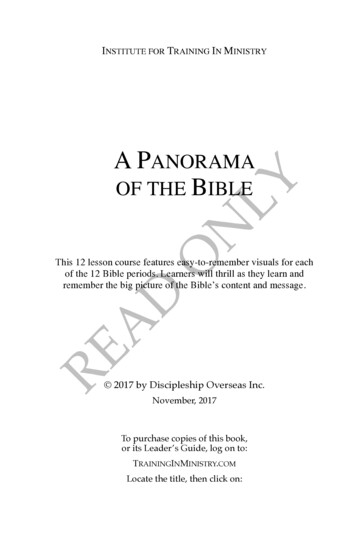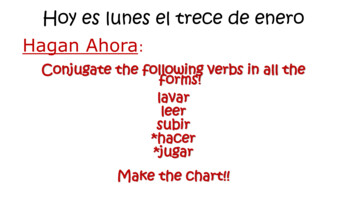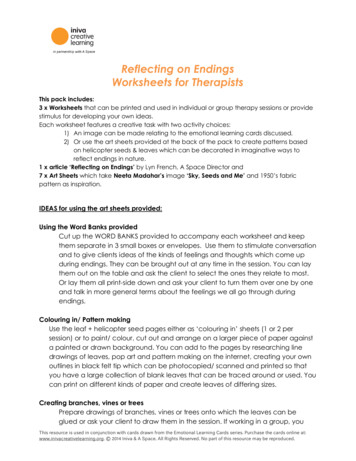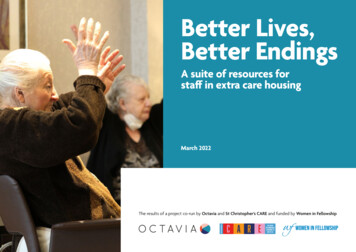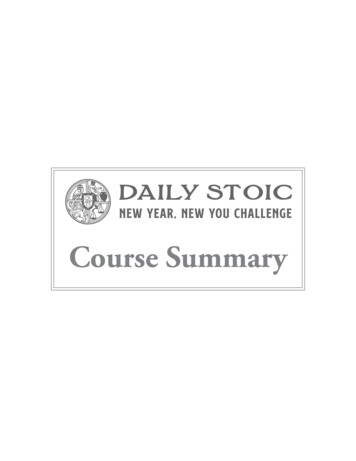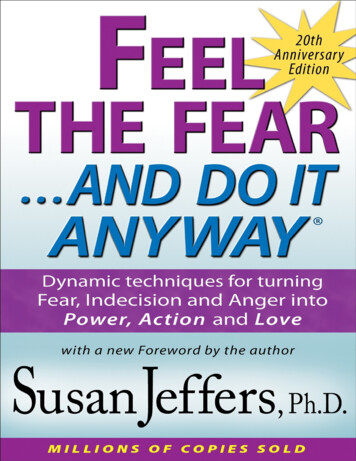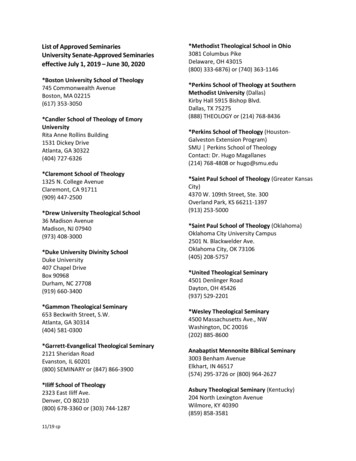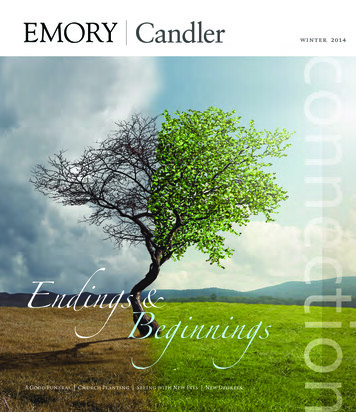
Transcription
winter 2014Endings &BeginningsA Good Funeral Church Planting Seeing with New Eyes New Degrees
Candler Connection Winter 2014Laurel Hanna, EditorCandler Connection is published by the Officeof Communications of Candler School ofTheology at Emory University and is distributedfree as a service to all alumni and other friendsin this issueof the school. Send correspondence regardingthe magazine to: Laurel Hanna, Co-Director ofCommunications, Candler School of Theology,1531 Dickey Drive, Atlanta, GA 30322 or emaillaurel.hanna@emory.edu.This magazine may be viewed online atwww.candler.emory.edu/news/connectionUnless otherwise noted, photography byEmory Photo/Video. Design by Wages Design,www.wagesdesign.comCopyright 2014, Candler School of Theology,Emory University. All rights reserved.www.candler.emory.eduCommunity:02 The CollectThe transformative spiritof endings and beginnings04 NewsFaculty:16 Required ReadingWhat faculty are reading now22 New Booksby Candler FacultyThe latest from Candler34 Now & Then:38 GivingGifts that are making a realdifference at CandlerTeresa Fry Brown andTed Smith talk teachingand preaching44 BenedictionProfessor emeritus Don Salierson endings and beginningsCorrections: The print edition of the Winter 2013issue of Candler Connection contained these errors:In “Return to Eden,” Sarah Gerwig-Moore’s namewas misspelled; in “From Hostility to Hospitality,”Sunlin Korean Methodist Church was incorrectlyidentified as Sunlin United Methodist Church. Weapologize for these errors in the print edition.Alumni:27 And A Little ChildShall Lead ThemA trio of beginnings forNancy & Shelvis SmithMather in South Sudan40 Class Notes
10182414Features:10The Good Funeral and the Empty TombThomas Lynch explores the link between death and eternal life18A Time to SowA bumper crop of Candler church planters sows the seeds of faith24Cut Dead But Still AliveGreg Ellison’s quest to end the stigmatization of African American young men3030Five Degrees of IntegrationCandler’s new degrees expand the possibilities for making a differenceCINDY BROWN
2Candler Connection Winter 2014The CollectThere’s a transformative spirit of both endingsand beginnings that leads us to a deeperunderstanding of ourselves and our call.
The Collect3Dear Friends,Woven through the endings and beginnings that punctuate our life’s storyis a common thread: change. And the past year at Candler has seen muchof it. We’ve witnessed the demolition of long-standing Bishops Hall andthe rise of a new building in its stead; celebrated the leave-taking of agraduating class and welcomed an assembly of new faces picking up theFLIP CHALFANTCandler mantle right behind them; and embraced the introduction of fivenew graduate degrees, created so that more real people can make a realdifference in the real world.The stories in this issue of Connection spotlight the transformative spirit of endings and beginnings, exploring the eternalcycling between the two and how both lead us into a deeper understanding and renewal of our call. We consider a range ofendings and beginnings, from rituals at the end of life to the birth of congregations in the neighborhoods that surround us;from stemming the tide of systemic injustice to forging new ministries. And of course, as we usher in 2014, we prepare tocelebrate Candler’s beginning as we honor the 100th anniversary of its founding in 1914.This summer, we mourned the passing of John Haralson Hayes, emeritus professor of Old Testament, who served onCandler’s faculty for 35 years and left behind a legacy of words, wisdom, and genuine friendship. His death brings deeperresonance to the final words of his 2010 book of wit and wisdom, If You Don’t Like the Possum, Enjoy the Sweet Potatoes:And when on our day the sun has set, let us pray that the darknessbe not long delayed, that short will be that evening journey into night.And may that night kiss us softly on the cheek, and embrace us tenderly in its keep.As Christians, our beliefs are rooted in the ultimate ending and beginning, the resurrection of Jesus Christ. Because of this,we face the future with confidence, even when we do not know what the “evening journey into night” will entail. We standpoised at an exciting juncture here at Candler as we turn from our first to our second century. May we embrace the sacredtension of our endings and beginnings as we continue to do God’s work in the world, both now and in years to come.Grace and peace,Jan LoveDean and Professor of Christianity and World PoliticsThe opening strains of the great hymn “Be ThouMy Vision” never fail to inspire Jan Love, a lifelongenthusiast of music and congregational singing.
Candler NewsSaying Goodbye to Bishops HallSometimes, there must be an endingBefore Bishops was demolished, Associate Professorstate-of-the-art technology and will conform tobefore a new beginning can occur. That was theof Worship and Liturgical Theology Ed Phillips ledLEED “green building” standards.case in spring of 2013 when Bishops Hall, Candler’sthe community in “A Rite to Acknowledge the Raz-home for fifty years, was demolished in order toing of Bishops Hall.” And then during spring break,As is fitting for a theology school building, manymake way for Phase II of the school’s new building.the building was taken down by a process calledof the materials from Bishops will be resurrected.“munching”—essentially, machines took bites outRed roof tiles were put aside for one of Emory’s newBuilt in 1957, Bishops Hall was synonymous withof the building. Within one week, Bishops was gone,residence halls. Most of the unused furniture wasCandler for generations of students, but it was notleaving room for a greener, more technology-friendlydonated to local charities. And debris from thesynonymous with technological advances: It couldbuilding to rise from its ashes.demolition was sorted and loaded into appropriatebins for recycling. Of the 880 tons of waste removednot support the latest in classroom technology,and the cost to modernize it would almost equalThat building is Phase II, which will house Pittsfrom the demolition site in March, 723 tons ofthe cost of a new building. So Candler officiallyTheology Library and the Wesley Teaching Chapel,concrete, 127 tons of metal, and 12 tons of wood weretook its leave of Bishops in 2008, moving intoand connect to the Rita Anne Rollins Building via arecycled or diverted—that’s a 97.95 percent recyclePhase I of its new building, now known as the Ritaglass atrium. Like Phase I, the building will featurerate. Not a bad parting gift, Bishops Hall. Thank you.Anne Rollins Building.
Candler News5Candler Celebrates 100 YearsIf 1914 “was an altogether splendid time to startLuke Timothy Johnson, Robert W. Woodruffto hear, and speak that word both clearly anda school of theology,” as Gary Hauk writes in hisProfessor of New Testament and Christian Originscompellingly,” he says.forthcoming book on the history of Candler, thenand chair of the Centennial Celebration Committee,2014 is certainly an altogether splendid time topoints to two dominant modes in Scripture thatTwo phases mark the turn from our first to ourrejoice in the school’s centennial.guide our celebration: narrative and prophecy.second century. In fall of 2014, we focus on“The Candler Centennial in Story and Prophecy”“Story gives expression to the memory of a people:highlight Candler’s historic significance withinis a yearlong celebration of the school’s 100th an-By faithfully and creatively remembering boththe larger Atlanta community and beyond. Inniversary, highlighting memories of the past andthe good and bad in its experience, the Candlerspring of 2015, we move to “Prophecy: Ad-visions for the future. It begins in August 2014 withcommunity is prepared once more to move intodressing the Future,” as Candler hosts a majorFall Convocation and the dedication of the finalthe future,” he explains.scholarly conference on theology to engage the“Story: Remembering the Past” in events thatphase of our new building and continues throughchallenges of the next century. Candler facultySpring Commencement 2015 with a slate of specialProphecy, says Johnson, is not so much about pre-will present papers proposing ways forward,guest lectures, musical performances, forums anddicting the future as it is about speaking a word toand distinguished theologians from outsideconferences, room dedications, alumni reunions,the present and thus affecting the future.Candler will respond as panelists.“As a school of theology committed to the serviceA full calendar of Centennial Celebrationof the church and the world, Candler must seek toevents and related details will be available atdiscern the word that the church and world needcandler.emory.edu later this spring. nexhibits in the new Pitts Theology Library, and thedebut of Hauk’s book.
6Candler Connection Winter 201401Candler WelcomesNew FacultyA Bevy of Laurelsfor Reynolds, Lösel 01Candler’s senior class in recognition of faithful andIn the fall of 2013, Candler welcomed two newAquinas Professor of Historical Theology Philip L.fellow at Emory’s Bill and Carol Fox Center forfaces to the faculty. Thomas W. Elliott, Jr. 87T, 97GReynolds and Associate Professor in the Practice ofHumanistic Inquiry.is the director of Contextual Education II, assistantSystematic Theology Steffen R. Lösel have receivedprofessor in the practice of practical theology,abundant honors this year. First the AssociationAcing the Third Degreeand director of the Teaching Parish program andof Theological Schools (ATS) and The Henry LuceVirginia Theological Seminary (VTS) has awardedministry internships. An elder in the North GeorgiaFoundation named them as two of the six HenryCharles Howard Candler Professor of Old TestamentConference of The United Methodist Church,Luce III Fellows in Theology for 2013-2014. As LuceCarol A. Newsom a Doctor in Divinity, honoris causa,he comes to Candler with 26 years of pastoralFellows, they will conduct research for a year andher third honorary doctorate. “Scholar, mentor,experience in local parishes. His work focuses onthen present their findings at a conference and forlecturer, teacher, visionary, and interpreter of textsWesleyan studies, polity, evangelism and mission,publication in religious journals. Lösel’s projectare a few of the terms that come to mind whenand contextual education. Nichole Renée Phillipsexplores the faith of Wolfgang Amadeus Mozartone thinks of you,” begins the citation from VTS.joins the school as assistant professor of religionthrough a musical and textual analysis of anthropo-“Where others have heard discord and contradic-and human difference. An ordained itinerant elderlogical, Christological, ethical, and eschatologicaltions in the text, you have discerned dialogue—ain the African Methodist Episcopal Church (AME),themes in his major operatic works. Reynolds willmultiplicity of voices that opens up a world ofPhillips focuses on the intersection of religion,explore Christian mystical theology in the westernpossibilities for meaning. Texts talk to one anotherpsychology, and culture; African American historytradition. Additional honors for both were icingand so do disciplines: the way you use sociology,and cultural studies; practical theology; and cul-on the cake: Noted as “equal parts pastor, scholar,psychology, and literary criticism has given us atural anthropology and ethnographic research. Sheand teacher,” Lösel received the 2013 “On Eagle’snew framework for interpreting Scripture. You havehas served on ministerial staffs of churches in NewWings” Excellence in Teaching Award, given byinspired a new generation of biblical scholars.”England and in the South.dedicated service [01]. Reynolds was named a senior
Candler NewsLiving Out Love 027faith communities, Candler’s YTI was theNearly a hundred attended the Women, Theology,YTI: 20 Years of ExploringQuestions that Shape Us 03and Ministry program’s Annual Women’s ForumIn the two decades since its launch in 1993, moreyouth ministry programs modeled after itfeaturing author and women’s advocate The Rever-than 1,000 high schoolers have attended Candler’sare scattered around the country.end Becca Stevens on “Living Out Love: Advocacygroundbreaking Youth Theological Initiative (YTI)for Women as a Theological Practice.” RecentlySummer Academy, exploring questions about“There is no doubt that YTI shapes leaders fornamed by the White House as one of 15 “Champi-faith, values, and culture that shape their youngtomorrow,” says Elizabeth Corrie, the program’sons of Change,” Stevens is founder of Magdaleneminds. This past July, more than 100 YTI mentors,director and assistant professor of youthand Thistle Farms, a community and social enter-staff, and participants from years past gatherededucation and peacebuilding at Candler.prise near Nashville, Tenn., that supports womenat Candler to celebrate the program’s 20threcovering from prostitution, tracking, addiction,anniversary with a slate of activities, including a“Many participants will become ordained clergy,and life on the streets. Magdalene, the residentialpanel discussion on 21st century youth ministry,and some will enter other fields. But no mattermodel, serves women for two years at no cost toworship, workshops, and a reunion banquetwhat their profession, they will have a sense thatresidents. Thistle Farms employs more than 40keynoted by YTI co-founders Craig Dykstra andGod has called them to work for the commonresidents and graduates who manufacture, market,Chuck Foster.good, drawing on their religious tradition as afirst of its kind. Now more than 50 summerand sell all-natural bath and beauty products in 200formative resource.”retail stores across the globe. The forum includedOriginally designed as a forum where youthpresentations by women of the Magdalene commu-could address theological questions andnity and a discussion session on action strategies forissues that weren’t discussed in their localwomen’s advocacy in Atlanta.0203
8Candler Connection Winter 20140405Bishops LeadEpiscopal Studies 041974, and they currently serve in churches,all who worship there. At the top of the list waschaplaincies, and social service agencies frominstalling state-of-the-art audio-visual equipment toCandler has tapped two bishops from the EpiscopalCalifornia to Maine.support enhanced presentations and live-streamingChurch to lead its Episcopal Studies program. Theworship services. Also important were attending toRt. Reverend Keith B. Whitmore, assistant bishopCannon Chapel Freshens Up 05long-standing maintenance issues and adding ablu-of the Episcopal Diocese of Atlanta, serves as direc-After more than three decades of almost daily use,tion stations for the ritual washing required by sometor of the program, and the Rt. Reverend Robertthe iconic William R. Cannon Chapel underwent itsfaiths. Besides these larger changes, other nips andC. Wright [04], bishop of the diocese, chairs thefirst building-wide renovation this summer. Built intucks included replacing carpeting and flooring, re-school’s Episcopal Studies Advisory Board.1981, the chapel—which hosts regular classes andsurfacing the ceiling, improving lighting, installingfive worship services a week for Candler students,new furnishings, repainting pews, refinishing the“I am thrilled that this team of leaders will build onplus gatherings for other religious groups at Emo-original lectern and altar, ensuring compliance withan already strong foundation in Episcopal Studies atry—was due for a makeover. Candler and Emory’sthe Americans with Disabilities Act, and rearrangingCandler to move us in new and creative directions forOffice of Religious Life teamed up in the effort tomeeting and teaching spaces, including the creationthe future,” says Dean Love.breathe new life into the space.of a room dedicated to spiritual formation.Candler features the oldest university-based Epis-Though not visually dramatic, the improvementscopal Studies program in the nation. More than 200address both the need for more current technologystudents have graduated since the program began inand the need to make the space hospitable for
Candler News9A Semester with BarbaraBrown Taylor 06Lay Theology InstitutePresents Pacini, Johnson 07The Professors Are INBest-selling author, Emory alumna, and EpiscopalThe Bill Mallard Lay Theology Institute at Candlerfree “Office Hours” webinar this spring semester.priest Barbara Brown Taylor 73C joined Candlerwill host two Disciple Scholars events this semester.The line-up includes Don E. Saliers on February 13,School of Theology for the fall semester as theOn February 16, Professor of Historical Theology“The Psalms of Lament”; Gregory C. Ellison II onAlonzo L. McDonald Family Chair on the Life andDavid Pacini [07] will present “Four Bibles, FourMarch 18, “Cut Dead But Still Alive”; and Carol A.Teachings of Jesus and Their Impact on Culture.Christs” at Mulberry Street United Methodist ChurchNewsom and Jennifer Ayres on April 24: “Food andDuring her tenure as the McDonald Chair, Taylorin Macon. On March 29, Luke Timothy Johnson,Faith: Eating as a Spiritual Practice.” The one-hourgave three major public addresses: “At Home withR.W. Woodruff Professor of New Testament andwebinars use the GoToWebinar platform, enablingUncertainty,” “Learning to Walk in the Dark,” andChristian Origins, will present “The Apostle Paul:you to view a live presentation, ask questions, and“The Virtuous Preacher.” Audio and video record-Oppressor or Liberator?” at Candler School of Theol-engage in conversation with your favorite faculty.ings of all three presentations are available in theogy. To register, visit candler.emory.edu/calendarRegister on the “Alumni & Friends” section of“Jesus & Culture” and “Special Events” albums onand navigate to the date of the event.Candler’s website, candler.emory.edu. Can’t makeEmory’s iTunes U site, itunes.emory.edu.Sharpen your tools for ministry by joining us for ait to the live session? You can access any of the past“Office Hours” webinars from our website.In addition to these public lectures, Taylor addressed smaller groups, engaged with studentorganizations, and taught a course that focused onexamining the image of Jesus through the eyes of0607CINDY BROWNthe world’s major faiths outside of Christianity.
The Good Funeral and the Empty Tomb11The Good Funeral and the Empty TombBy Thomas LynchAn adaptation of a lecture given by poet andundertaker Thomas Lynch during his tenureas the McDonald Chair in spring 2013“A good funeral.” I first heard that from my father, who was a funeral director. He used to comehome from work when I was a kid, sit down at the dinner table, and talk about how he’d had “acouple of good funerals” that day—by which he meant, it got the dead where they needed to go andthe living where they wanted to be. That became for me a sort of rule of thumb: A good funeral getsboth the dead and the living where they need to be.In my time as a visiting professor at Candler, I’vebecause it affirms that every tribe and sect, religiousto everyone except the actual corpse, which is oftenlearned to provide a scriptural predicate for muchand ethnic community is obliged to figure out whatdismissed, disappeared without rubric or witness,of what I do and write and say. And so, this, fromto do with their dead. And so when Joseph theout of sight, out of mind. So the visible presence ofthe Gospel of John:Arimathean, in league with Nicodemus, petitionedthe Pope’s body at the Pope’s funeral struck manyPilate for the body of Christ, they were acting outas an oddity, a quaint relic of old customs. Howa primal office of their species and the particular“Catholic” some predictably said, or how “Ital-dictates of their tribe.ian,” or “Polish,” or “traditional,” or “barbaric.” OrAfter these things, Joseph of Arimathea, who wasa disciple of Jesus, though a secret one because of hisfear of the Jews, asked Pilate to let him take awaythe body of Jesus. Pilate gave him permission;so he came and removed his body. 39 Nicodemus,who had at first come to Jesus by night, also came,bringing a mixture of myrrh and aloes, weighingabout a hundred pounds. 40 They took the bodyof Jesus and wrapped it with the spices in linencloths, according to the burial custom of the Jews.41Now there was a garden in the place where hewas crucified, and in the garden there was a newtomb in which no one had ever been laid. 42 And so,because it was the Jewish day of Preparation, andthe tomb was nearby, they laid Jesus there.—John 19:38-42, NRSV38“when in Rome ” the perpetually beleaguered cableIt was much the same eight years ago at the VaticanTV commentators would say.when Pope John Paul II died. That first week of April2005 was dominated by images of the dead man’sIn point of fact, what happened in Rome that weekbody vested in red, mitered, and laid out among thefollowed a pattern as old as the species—it wasfaithful with bells and books and candles, blessed“human,” this immediate focus on the dead and thiswith water and incense, borne from one station tosense that the living must go the distance with them.the next in what began to take shape as a final jour-Most of nature does not stop for death. But we do.ney. The front pages of the world’s newspapers wereWherever our spirits go, or don’t, ours is a speciesuniform in their iconography: a corpse clothed inwhich has learned to process grief by processing thesumptuous vestments from head to toe, still as stoneobjects of our grief—the bodies of the dead—fromand horizontal. Such images flickering across theirone place to the next. We bear mortality by bearingubiquitous screens no doubt gave pause to manymortals—the living and the dead—to the brink ofAmericans for whom the presence of the dead ata uniquely changed reality: Heaven or Valhalla ortheir own funerals had gone strangely out of style.Whatever Is Next. We commit and commend themOf these verses surrounding the burial of Christ,into the nothingness or somethingness, into thewhat always impressed me is the one that readsFor many bereaved Americans, the relatively newpresence of God or God’s absence. Whatever after-“according to the burial customs of the Jews,”“celebration of life” funeral involves a guest list openlife there is or isn’t, human beings have marked their
CINDY BROWNceasing to be by going the distance with theirthe earth. The lexicon and language are full of suchunresponsive and decomposing lump of matter nextdead, getting them to the edge of a new reality—towisdoms. Thus, our “humic density,” as the scholarto her should be removed. She drags him out by thethe tomb or the fire or the grave, the holy tree orRobert Pogue Harrison calls it, the notion thatankles and begins her search for a cliff to push himdeep sea, whatever sacred space of oblivion weeverything human—our architecture and history,over or a ditch to push him into. Or maybe she digsconsign them to. And we’ve been doing this sinceour monuments and cities—all rooted in and risinga pit in the earth to bury him because she doesn’tthe beginning.from the humus, the earth, the ground in which ourwant wild animals attracted to his odor. Or maybedead are buried, is what eventually defines us.she builds a fire, a large fire, around and atop hisAs Christians, our theology is shaped by our escha-rotting body and feeds it with fuel until the body istology; our living faith informed by our best hopesYears ago I took to trying to imagine the first humanconsumed. Maybe she keeps one of the bones for afor the dead. Thus, the defining truth of our Christi-widow awakening to the dead lump of a fellow nexttotem or remembrance. Or let’s say she lives near aanity—the empty tomb—proceeds from the definingto her, stone still under the hides that covered andbody of water and counts on the fish to cleanse histruth of our humanity: We fill tombs. The mysterywarmed them against the elements. I always imag-remains. Maybe she enlists the assistance of othersof the resurrection to eternal life is bound inextri-ine a cave and primitive tools and art and artifacts.of her kind in the performance of these duties, andcably to the certainty of the cross of suffering andThey have fire and some form of language andthey do their part, sensing that they may need exactlydeath. Indeed, the effort to make sense of it all, thesocial orders. This first human widow wakes up tothis kind of help in the future.religious impulse, owes to our primeval questionsfind the man she’s been sleeping with and cookingabout the nature of death. Save for these uniquelyfor and breeding with gone cold and quiet in a wayHere is where the course of history is set. It has tohuman curiosities about last things and eschatolo-she had not formerly considered. Depending on thedo with the momentary pause before she turns andgies and the liturgies we construct to answer them,weather, sooner or later she begins to sense thatleaves the cave, or the ditch or the pit or the firewe would be so much road-kill and windfall, oursomething about him has changed quite utterly andor the pond or whatever oblivion she has chosenlives and deaths unmarked and unremarkable. Likeirreversibly. Probably she smells the truth of thisfor him. In that pause she stares into the oblivionbaptisms and nuptials, we do funerals to addresswithin a matter of a day or two. And what makes hershe has consigned him to and frames what are thethe uniquely human questions—what is permanent,human is that she figures she’d better do somethingsignature questions of our species: Is that all there is?what is passing, what is the meaning of life and love,about it. Let us, for a moment, consider her options.Why is he cold? Can this happen to me? What comes next?suffering and death. Gladioli and goldfish are notmuch troubled by these things. Only humans are.Of course, there are other questions, many more, butPerhaps she gathers her things together and followsall of them are uniquely human, because no otherthe nomadic herd of her group elsewhere, leavingspecies ponders such things. This is when the firstOurs is the species bound to the dirt, fashionedthe cave to him, in which case we could call it hisglimpse of a life before or beyond this one begins tofrom it, according to the Book of Genesis (Gen 2:7).tomb. Or maybe she likes the decor of the placeflicker into the species’ consciousness and questionsThus human and humus occupy the same page of ourand has put some of herself into the improvementsabout where we come from and where we go take updictionaries because we are beings “of the soil,” ofso decides that she should stay and that the nowmore and more of the moments not spent on
The Good Funeral and the Empty Tomb13“No form of human life,” writes the sociologistbetween the living and the dead that is unique inZymunt Bauman in Mortality, Immortality and Otherhuman history. Furthermore, this estrangement, thisLife Strategies, “has been found that failed to patterndisconnect, this refusal to deal with our dead (theirthe treatment of deceased bodies and their posthu-corpses), could be reasonably expected to handicapmous presence in the memory of the descendants.our ability to deal with death (the concept, the ideaIndeed, the patterning has been found so universalof it). And a failure to deal authentically with deaththat discovery of graves and cemeteries is generallymay have something to do with an inability to dealaccepted by the explorers of prehistory as proof thatauthentically with life.a humanoid strain whose life was never observeddirectly had passed the threshold of humanhood.”rudimentary survival. Maybe the way the sun risesIt bears mentioning that while this estrangement iscoincident with the increased use of cremation as aand sets or the seasons change or the tide ebbs andI want to emphasize that Bauman finds two elementsmethod of disposing of the dead over the same half-flows begin to replicate her own existence. Andto this “threshold of humanhood.” First, “to patterncentury, and may be correlated to it, cremation is notmaybe whatever made the larger and the smallerthe treatment of deceased bodies,” and secondly,the cause of this estrangement. Indeed, cremationlights in the night sky and great yellow disk that“their (the dead’s) presence in the memory ofis an ancient and honorable and effective methodmoves across the sky had something to do with herdescendants.” And when we find evidence of ancientof body disposition, but in most cultures where it isand the man whose body she is disposing of.graves and cemeteries, crematories or other sites ofpracticed it is done publicly in ceremonial and com-final disposition, we can assume that they are venuesmemorative venues, whereas in North America veryAnd here is the point I am trying to make: that thewhere humans sought to deal with death by dealingoften it is consigned to an off-site, out-of-sight, in-contemplation of the existential mysteries, thosewith their dead—by treating their deceased bodies industrial venue where everything is handled privatelyaround being and ceasing to be, is what separatesways that said they intended to keep “their posthu-and efficiently. Only in North America has cremationhumans from the rest of creation; and that our hu-mous presence in (their) memory.”lost its ancient connection to fire, because it is somanity is, therefore, directly tied to how we respondrarely actually witnessed. Here, cremation has be-to mortality. In short, how we deal with our dead inAnd this formula—dealing with death by dealingcome synonymous with disappearance, not so muchtheir physical reality and how we deal with death aswith the dead—defined and described and workedan alternative to burial or entombment, rather anan existential reality define and describe us in pri-for humans for forty or fifty thousand years all overalternative to having to bother with the dead body.mary ways. Furthermore, the physical reality of deaththe plane
Theology at Emory University and is distributed . free as a service to all alumni and other friends of the school. Send correspondence regarding the magazine to: Laurel Hanna, Co-Director of Communications, Candler School of Theology, 1531 Dickey Drive, Atlanta, GA 30322 or email laurel.hanna@emory.edu. This magazine may be viewed online at
